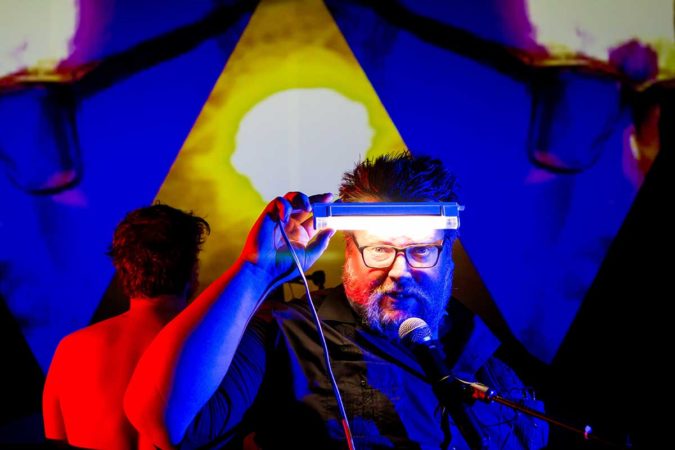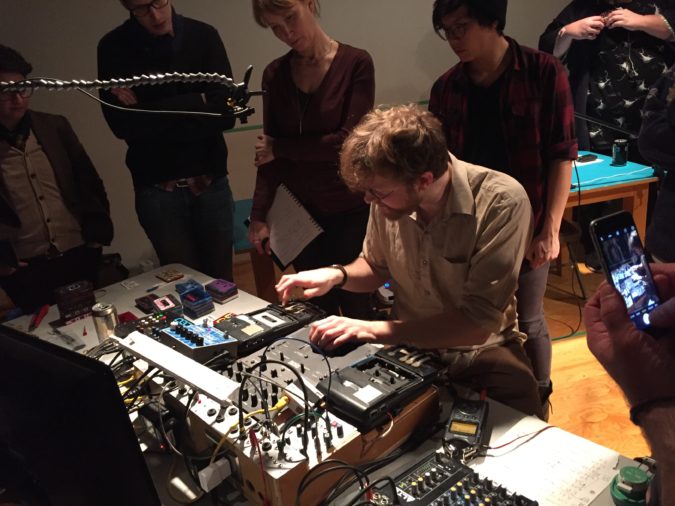The weird and wired future of Decoder 2017 – A Curatorial Statement by Tim Carlson
February 03, 2016
G. Lucas Crane’s virtuoso performance on a mad assemblage of old cassette decks, faders, effect pedals, cameras and monitors is thrilling to behold.
But virtuosity is just not enough – for either him or his collaborators creating Decoder 2017.
“I should have no time to think,” Crane says, but rather aims to ride “the body rhythm” that flows from playing a combination of analogue and digital tech.
Pushing Crane into “unsafe territory where he has no more mind,” says actor/designer Jim Findlay, is the most relevant way to channel the ghost of William S. Burroughs in 21st-century performance. He likens it to Burroughs’ approach to writing and art making, cut up and reassembly to discover new possibilities. The same goes for Findlay’s work on stage: “I want to go where I don’t know I’m going to go.”

With video designer Keith Skretch playing the notes between control and randomness off stage, Findlay performing who-knows-what’s-next text from Burroughs’ Nova Trilogy cut up and fed into his ear (while wired to body sensors that fire off new sounds and images at the flick of a pinky), Crane works his decks to the point where man and machine begin to meld.
Despite its theatrical elements, director Mallory Catlett refers to the show as a concert: the Skretch/Findlay/Crane trio in something akin to an improvisational jazz performance or, say, the state of communication that Neil Young achieves when he and Crazy Horse are “breaking through the wall.” It’s an unknown path fraught with potential failure but magic moments reveal unknown pleasures.
Conceived as a concert better suited to a club venue than theatrical stage, this phase of Decoder development was commissioned by Theatre Conspiracy and will be presented with the PuSh Festival Thursday night at the Fox Cabaret — the new home of Club PuSh.
Since its inception, the PuSh/Conspiracy commissions for the club aimed to provide “a platform for experiment,” and Decoder 2017 fits squarely into that criteria, if no other.
Catlett and Restless NYC opened their temporary laboratory (Playwrights Theatre Centre’s Test Kitchen) to 15 local and visiting artists on Monday night for a behind-the-scenes peek of the show in progress and a Q&A about technology in performance.

While technology provides the platform for the Decoder experiment, the artists say, the tech is not the driving force. Burroughs is.
“The technology is a system to approach and discover the source material,” says Catlett. “The question is, ‘how do we reveal the conversation we are having with Burroughs about how we live now?’ ”
“Burroughs was extremely prescient about information age,” says Crane. “The Electronic Revolution was extremely influential on the emerging electronic music scene in the ‘70s.” He points out that now anyone with a smartphone can use the technology to capture, edit and publish media to “smash the control state” that uses technology for oppression. In Decoder 2017, there is an aim to discover the next concept, post-Burroughs.
The New York-based artists all resist the temptation to use the technology “well” as much as they find discomfort in repeatability or virtuosity.
“I like to find a piece of technology and learn how to communicate with it,” Catlett says. “The idea is to find a way for (this collection of tech) to become operational and generate something new.”
Final word from Findlay, who described the reaction of a tech exec following one of his other performance pieces. “He came up to me after the show and said, ‘You’re using the wrong gear for what you’re trying to do, and not only that, you’re using it all wrong. But what you did sure is fascinating.”
Be transported to another future in Decoder 2017 this Thursday, February 4 at Club PuSh at The Fox Cabaret. Book tickets on your PuSh Pass, Youth Passport or as single tickets online.